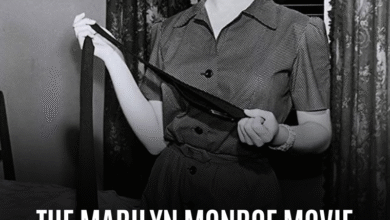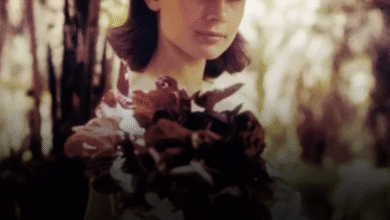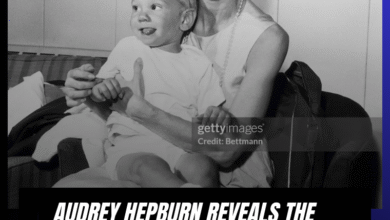Marilyn Monroe’s Secret Intellectual Side: What She Was Really Reading in 1955!
OPINION: This article may contain commentary which reflects the author's opinion.
In a striking photograph taken by Eve Arnold in 1955, Marilyn Monroe is captured sitting on a bench in a colorful striped bathing suit, engrossed in a copy of Ulysses by James Joyce. The image, which portrays the actress—often confined to the role of a “dumb blonde”—reading one of the most complex and challenging texts of the modernist literary canon, immediately invites doubt. Monroe, the quintessential sex symbol, reading Ulysses? Surely, this cannot be true. Yet the truth behind the photograph is both profound and telling, illuminating the gap between how Monroe was perceived by the public and the intellectual woman she truly was.
The Image of the “Dumb Blonde” and the Misogynistic Doubts
Monroe’s career was built on a persona carefully crafted by Hollywood—a stunning, seductive figure whose intelligence was often overshadowed by her beauty. Characters like Lorelei Lee in Gentlemen Prefer Blondes (1953) were designed to amplify this image, playing on the comedic contrast between her alluring exterior and supposed naivety. As Lorelei, she was a savvy woman masquerading as airheaded, playing the system with impeccable timing and wit, all while making the audience believe she was just a pretty face. Unfortunately, Hollywood—and the world at large—was often too enamored with her exterior to recognize the depth behind it.
When this photograph of Monroe with Ulysses surfaced, the immediate reaction from many was disbelief. There were widespread doubts about her ability to read such a complex text. Even in a time when female intellectualism was still often dismissed, the suggestion that Monroe could engage with Joyce’s notoriously difficult work was met with skepticism. Critics and observers were quick to dismiss the image, assuming that Monroe had been posed with the book by Arnold and was not truly reading it. The idea that she could understand Ulysses, a novel filled with intricate symbolism and linguistic innovation, was simply too difficult for many to accept.
However, this doubt about Monroe’s intellectual capacity was rooted in misogyny. The photograph, despite its authenticity, became a target for those who couldn’t fathom that a woman with such captivating beauty could possess any depth beyond her looks. What they failed to understand was that Monroe was far from a simple “dumb blonde” and, in fact, was a woman with a sharp mind and a passion for learning.
Monroe’s True Intellectual Curiosity
Marilyn Monroe was, indeed, an avid reader. She had a personal library that contained over 400 books, ranging from classic novels and poetry to philosophical essays and works on psychology. Monroe’s intellectual pursuits were not a mere façade; she was genuinely passionate about learning. According to photographer Eve Arnold, when she visited Monroe on a beach in Long Island, the actress revealed that Ulysses was one of the books she kept in her car and had been reading for a while. Monroe loved the sound of the text and would read it aloud to herself, despite finding it challenging. She admitted that she could not read it consecutively, instead tackling it in parts—a method recommended by many Joyce scholars.
Arnold’s account dismisses the notion that Monroe was posed with the book for the sake of the photograph. The authenticity of Monroe’s engagement with Ulysses is clear. She was not only reading the novel; she was attempting to understand it, as challenging as it was. This image thus becomes a powerful statement about Monroe’s intellectual aspirations, confronting the stereotype that she could only be defined by her public persona.
The Symbolism of “Penelope” in Ulysses
The timing of the photograph is significant. Monroe is pictured holding Ulysses open to the final chapter, “Penelope,” which centers on Molly Bloom’s monologue as she reflects on her life, her loves, and her desires. In contrast to the rest of the book, which is filled with a cacophony of voices, “Penelope” is intimate and singular. It’s a reflection of Molly’s thoughts while lying in bed, free from the constraints of the outside world. In her internal monologue, Molly confronts her own sexuality and desires, declaring her independence from the expectations placed on her as a woman.
This chapter has long been a subject of academic debate. On one hand, some view it as deeply anti-feminist, arguing that Molly Bloom is portrayed only as a sexual being, defined by her relationships and her pleasures. On the other hand, others see the chapter as an empowering moment for women in literature—Molly’s unapologetic expression of her desires is seen as a defiance of the era’s societal expectations of women. She is not a passive figure; she is bold, sexual, and independent.
Monroe’s association with Ulysses and the Penelope chapter is powerful for many reasons. The image of her reading Joyce’s novel, especially at the closing chapter, can be seen as a metaphor for Monroe’s own struggles with her image and the constraints placed upon her. Like Molly Bloom, she was a woman whose public image was shaped by others, but she yearned for more—a life beyond the roles she was typecast into, a life of intellectual curiosity and personal freedom. Monroe, in a sense, was crafting her own postmodern “Penelope,” a woman who resisted being confined by the expectations of society and who sought deeper meaning in her own way.
Monroe and the Complexity of Female Identity
Monroe’s engagement with Ulysses reflects a larger, often overlooked aspect of her persona: her desire to be recognized as a multifaceted woman. She wanted to be seen not just as a sex symbol, but as someone who could hold her own in intellectual circles. The public image of Monroe, as carefully curated by Hollywood, often obscured her complexity, but in her personal life, she actively pushed back against this simplification. The Ulysses photograph stands as a symbol of that resistance—an act of defiance against the reductive labels placed on her.
By reading one of the most difficult works of modernist literature, Monroe was asserting her autonomy over her identity. She was reminding the world that there was more to her than what met the eye. And in doing so, she was reclaiming her narrative in a way that few people recognized at the time.
Conclusion: Marilyn Monroe as a Feminist Icon
The photograph of Marilyn Monroe reading Ulysses is not merely an image of a Hollywood star; it is a statement of intellectual engagement, personal depth, and defiance against the limitations imposed upon her. Monroe’s love for literature, her commitment to self-education, and her desire to be more than just a beautiful face reflect the essence of a woman who longed for autonomy in both her personal and public life. The Penelope chapter of Ulysses represents a woman’s reclaiming of her voice, and in many ways, it mirrors Monroe’s own journey toward self-empowerment. In the end, it’s clear that Monroe’s intellectual curiosity, much like her acting talent, was far more profound than the world was willing to acknowledge at the time.



